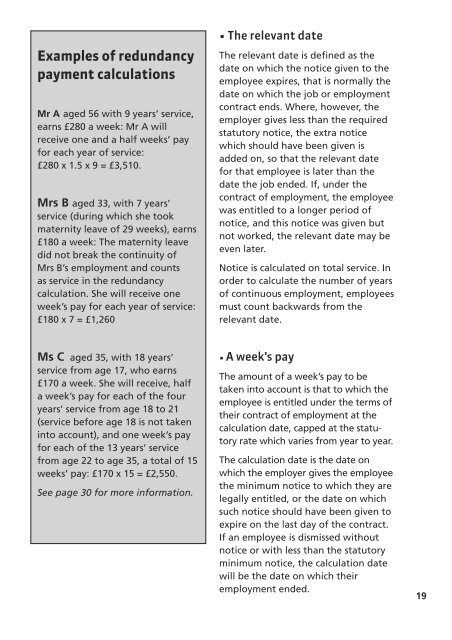Redundancy - Unite the Union
Redundancy - Unite the Union
Redundancy - Unite the Union
Create successful ePaper yourself
Turn your PDF publications into a flip-book with our unique Google optimized e-Paper software.
Examples of redundancy<br />
payment calculations<br />
Mr A aged 56 with 9 years’ service,<br />
earns £280 a week: Mr A will<br />
receive one and a half weeks’ pay<br />
for each year of service:<br />
£280 x 1.5 x 9 = £3,510.<br />
Mrs B aged 33, with 7 years’<br />
service (during which she took<br />
maternity leave of 29 weeks), earns<br />
£180 a week: The maternity leave<br />
did not break <strong>the</strong> continuity of<br />
Mrs B’s employment and counts<br />
as service in <strong>the</strong> redundancy<br />
calculation. She will receive one<br />
week’s pay for each year of service:<br />
£180 x 7 = £1,260<br />
• The relevant date<br />
The relevant date is defined as <strong>the</strong><br />
date on which <strong>the</strong> notice given to <strong>the</strong><br />
employee expires, that is normally <strong>the</strong><br />
date on which <strong>the</strong> job or employment<br />
contract ends. Where, however, <strong>the</strong><br />
employer gives less than <strong>the</strong> required<br />
statutory notice, <strong>the</strong> extra notice<br />
which should have been given is<br />
added on, so that <strong>the</strong> relevant date<br />
for that employee is later than <strong>the</strong><br />
date <strong>the</strong> job ended. If, under <strong>the</strong><br />
contract of employment, <strong>the</strong> employee<br />
was entitled to a longer period of<br />
notice, and this notice was given but<br />
not worked, <strong>the</strong> relevant date may be<br />
even later.<br />
Notice is calculated on total service. In<br />
order to calculate <strong>the</strong> number of years<br />
of continuous employment, employees<br />
must count backwards from <strong>the</strong><br />
relevant date.<br />
Ms C aged 35, with 18 years’<br />
service from age 17, who earns<br />
£170 a week. She will receive, half<br />
a week’s pay for each of <strong>the</strong> four<br />
years’ service from age 18 to 21<br />
(service before age 18 is not taken<br />
into account), and one week’s pay<br />
for each of <strong>the</strong> 13 years’ service<br />
from age 22 to age 35, a total of 15<br />
weeks’ pay: £170 x 15 = £2,550.<br />
See page 30 for more information.<br />
• A week’s pay<br />
The amount of a week’s pay to be<br />
taken into account is that to which <strong>the</strong><br />
employee is entitled under <strong>the</strong> terms of<br />
<strong>the</strong>ir contract of employment at <strong>the</strong><br />
calculation date, capped at <strong>the</strong> statutory<br />
rate which varies from year to year.<br />
The calculation date is <strong>the</strong> date on<br />
which <strong>the</strong> employer gives <strong>the</strong> employee<br />
<strong>the</strong> minimum notice to which <strong>the</strong>y are<br />
legally entitled, or <strong>the</strong> date on which<br />
such notice should have been given to<br />
expire on <strong>the</strong> last day of <strong>the</strong> contract.<br />
If an employee is dismissed without<br />
notice or with less than <strong>the</strong> statutory<br />
minimum notice, <strong>the</strong> calculation date<br />
will be <strong>the</strong> date on which <strong>the</strong>ir<br />
employment ended.<br />
19

















